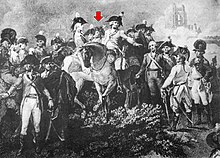Siege of Valenciennes (1793)
The siege of Valenciennes from May 24th to July 28th 1793 was part of the First Coalition War and ended with a victory for the allied troops of the English, Austrians and Dutch. The French, under the command of General Custine, tried twice in vain to bring relief to the fortress . On August 1st the crew was surrendered, and the English corps of the Duke of York , which had become free , was dispatched to the siege of Dunkirk .
First Coalition War (1792–1797)
Verdun - Thionville - Valmy - Lille - Mainz (1792) - Jemappes - Namur - Neerektiven - Mainz (1793) - Famars - Valenciennes (1793) - Arlon (1793) - Hondschoote - Meribel - Avesnes-le-Sec - Pirmasens - Toulon - Fontenay-le-Comte - Cholet - Lucon - Trouillas - Menin - Wattignies - Biesingen - Kaiserslautern (1793) - First Battle of Weissenburg (1793) - Second Battle of Weissenburg (1793) - Boulou - Tourcoing - Tournay - 13th Prairial - Fleurus - Vosges - Aldenhoven - San-Lorenzo de la Muga - Genoa - Hyeres - Handschuhsheim - Mainz (1795) - Loano - Montenotte - Millesimo - Dego - Mondovi - Lodi - Borghetto - Castiglione - Mantua - Siegburg - Altenkirchen - Wetzlar - Kircheib - Kehl - Kalteiche - Malsch - Neresheim - Deining - Amberg - Würzburg - Rovereto - Bassano - Limburg - Biberach I - Emmendingen - Schliengen - Arcole - Fall von Kehl - Rivoli (1797) - St. Vincent - Diersheim - Santa Cruz - Neuwied - Camperduin
prehistory
The Austrian army under the command of Prince Friedrich Josias of Saxe-Coburg succeeded in pushing the French out of the Valenciennes area at the beginning of April 1793 and enclosing both this fortress and Condé-sur-l'Escaut . From April 8, the coalition blocked the city of Conde and occupied the forest of Raismes , Vicogne and Hasnon . On April 20, the English had landed in Ostend under the Duke of York and marched to Tournai , while the Dutch, under the Hereditary Prince of Orange, covered the lines in West Flanders as far as Lille . The first attempt at relief by the French under General Drouot de Lamarche failed on May 1st and the second on May 23rd during the Battle of Famars . The defense of the then completely enclosed fortress Valenciennes had General Jean Henri Becays Ferrand , who had about 7000 men of regular troops.
March
The main imperial army had its vanguard , General Benjowzky's corps, between Onnaing and Saint-Saulve . The first meeting under Major General Ferraris had established itself between Onnaing and Rombies , behind it in the second line, the corps of the FML Colloredo encamped as far as Quarouble . Major General Otto's light troops covered the middle meeting on a line between Saint-Saulve - Estreux and Curgies . Austrian detachments under the princes of Württemberg blocked Condé and General Latour observed the fortress line between Maubeuge von Bettignies . Further troops under the Prince of Reuss had occupied Bavay . The English corps under the Duke of York secured the line between Tournai and Maulde , the Prussian corps under Knobelsdorff had occupied the line from Saint-Amand, Lecelles to Maulde . The Dutch Corps under the Hereditary Prince of Orange secured between the North Sea and the Lys section with concentration against Menin . The Austrian corps under Count Clerfayt camped on the left between Vicogne and the Scheldt at Escautpont . On May 8, the commander-in-chief of the French Northern Army, General de Dampierre, fell while attempting to relieve the nearby city of Condé, which was also besieged, and his right thigh was torn off by a cannonball at Raismes .
course
Closer containment
After the French camp at Famars had been taken , the fortress of Valenciennes was completely enclosed on May 24th. The Duke of York was entrusted with the command of the blockade troops and he took his headquarters in Estreux ; General Ferraris was in charge of the technical organization of the establishment of Onnaing. The strength of the troops was at the beginning 37 battalions and 29 squadrons with about 24,000 men (21,136 men and 2,812 horsemen), but these were soon increased to 30,000 men. The Austrian pioneer lieutenant colonel Zach planned to build two dams through the flooded valley of the fortress, one over the Rhonelle to Trith; the second to Saint-Léger . An additional connection should lead from Maing to Trith and connect there with the first dam. Construction of these dams began on the morning of May 25th.
Imperial troops under Field Marshal Lieutenant Count Erbach-Schönberg with 12 battalions (9,623 men and 976 riders) overran the place on the north and east sides. They stood in a semicircle around Soultair, on the road to Le Quesnoy via St. Saulve to Beuvrages and along the road to Saint-Amand-les-Eaux - the English troops joined the imperial forces on the left: 12 battalions, 4 squadrons ( 3213 men and 405 riders) under Generals Abercromby , Lake, and Dundas ; they reached from Saultain to Aulnoy , or from the road to Le Quesnoy to the Rhonelle. Between the Rhonelle and the Scheldt were the bulk of the Hanoverians 5 battalions and 4 squadrons (2,670 men, 353 horsemen) under Generals Hammerstein and Oeynhausen ; General Wallmoden stood on the left bank of the Scheldt with the remains of the Hanoverians, 8 battalions, 13 squadrons (4,266 men and 1,078 horsemen); his position reached from Saint-Léger to the road to St. Amand. Another Austrian detachment was deployed near St. Saulve under Major General Kray .
siege
On June 13th the heavy siege gun had finally arrived in front of Valenciennes, all sapper work was finished and secured, at 10:00 p.m. 4,600 men of the imperial and Hanoverian troops began to open the trenches. On June 14th at 8 a.m. the first parallel was already finished, she leaned left on Marly and continued on the road that ran through this place towards Le Quesnoy. On the morning of June 15, a battery was prepared at the level of the Moulin de Rouleux and connected to the trench leading to St. Saulve. A French attack on the right wing destroyed a battery built off Anzain. Early in the morning of June 18, General Ferraris opened fire from all the batteries against the walls. The inner district of Valenciennes had been burning in several places since June 13th, more houses were being destroyed by the flames every day and on June 21st the tower of the great St. Nicholas Church collapsed. On June 26, the siege had progressed so far that the allies were able to blow up part of the outer works through three mines. Since the 24th, the batteries from the first and second parallel hurled about 42,500 bullets into the fortress, including 2,526 incendiary balls and 10,723 bombs. In addition, since June 17th the English had brought six 18 pounders and six 50 pound mortars into position at la Briquette.
On July 10th, the besiegers received a troop reinforcement through the arrival of 5 battalions of Hessian troops under General Wurmb , which were supposed to secure in the south on the heights between Jalain and Préseau . The assault was to be carried out by the two divisions under FML Count Erbach and Major General von Wenckheim against the large and small redoubt . The first main division was divided into two columns, one of which (English and Hesse under General Abercromby) had to attack the protruding corner of the Ravelin , the other (imperial troops under Wenckheim) the redoubt of the right bulwark. In order to divide the attention and forces of the enemy, Major General Kray attacked and captured the Rochus Schanze and Lieutenant Colonel Jellachic at the same time as the hamlet of St. Vast-en-Ville in front of the citadel . As soon as the ski jump at St. Vasten-Ville was destroyed and the earthworks at this homestead were overturned, these positions were given up again.
handing over
On the morning of July 26th, the Duke of York ordered the city to surrender - in the evening the garrison asked for a 24-hour ceasefire. On the morning of July 26th, a hostile parliamentarian brought proposals for an honorable surrender and threatened a storm if they were rejected. The request was approved by 4:00 p.m. on July 27th. General Ferrand then called a council of war, all opinions voted for the surrender. General Kilmaine , commander-in-chief of the part of the French Northern Army encamped between Bouchain and Cambrai , as well as the Minister of War Bouchotte and the members of the welfare committee knew that the fortress could hold no more than six weeks. It was high time to surrender, as the fortress also had three open breaches and half the city was in ashes. The commissioners of the convention finally negotiated the free withdrawal of the occupation into the interior of France. General Ferrand had to hand over the city and citadel of Valenciennes to the Duke of York under favorable conditions on free withdrawal.
On August 1, the garrison, which was still 5000 strong, withdrew through the gate of Cambrai to the heights of Famars, where they laid down their arms. The besiegers stood in lines on both sides of the street as far as the leasehold of la Briquette, but on the above-mentioned heights marched in a large square. As the French battalions got there, they stretched their rifles and were then escorted to Avesnes-le-Sec by cavalry . The loss of the Allied Siege Corps consisted of 35 officers and 1250 men.
consequences
The garrison of Valenciennes had held out for 65 days, notwithstanding the terrible bombardment, because they had hoped to the last of General Custine's relief. The Valenciennes fortress was handed over to the Allies, the crew received a free withdrawal for the promise not to fight the Allied Powers during the entire war. The imperialists lost 5 officers and 172 men dead, 27 officers and 951 men wounded. Just a few days before Valenciennes fell into the hands of the allies, Mainz suffered a similar fate. The double victory was celebrated on August 2nd with all the allied armies in the Netherlands. The English contingent that had become free began with the siege of Dunkirk , but this failed as a result of the defeat at Hondschoote on September 8th.
literature
- Maximilian Joseph Carl von Ditfurth: History of the campaign of 1793 in Flanders , Verlag J. Bohne, Kassel 1839, p. 54 f.
- Anton Johann Groß-Hoffinger: Archduke Karl of Austria and the wars of 1792–1794 , Verlag Carl B. Lorck, Leipzig 1847, p. 91 f.




